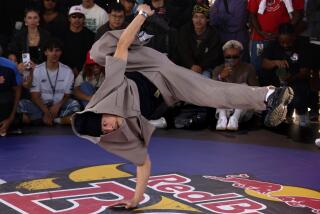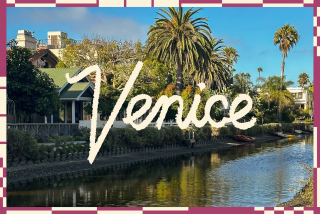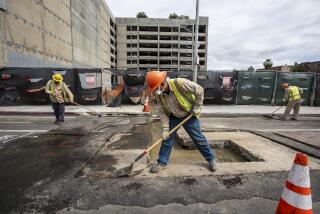On the Water : Venice and Marina del Rey Share More Than the Ocean
Abbot Kinney, an eccentric visionary, built the city of Venice upon a mosquito-ridden swamp on the edge of the Pacific in 1904, envisioning the rise of a new American cultural center. Instead, his Venice became known as a carny town, a home for dreamers and hard cases, a reputation that spurred sportsmen, pleasure seekers and artists to migrate there. During World War I, Kinney campaigned to have a deep-water naval harbor built at the southern end of his city to provide coastal protection against enemy U-boat attacks. At the same time, Los Angeles clergy, temperance leaders and editorialists were waging a war to close Veniceâs saloons and other allurements. Nearly 50 years after Kinneyâs harbor plan was first broached, Marina del Rey was opened on the site as home to 6,000 small pleasure craft. The passage of time has brought new buildings and new faces; few physical vestiges of those old days remain. In Venice and Marina del Rey, though, thereâs still room for individual vision.
Long, dawn-light shadows follow tiny shore birds as they dash away from the rush of water after each wave crashes on a deserted Venice beach. Fifteen yards from shore, Ed Perry holds back the 21-foot dory for a moment and waits for a steep wave to crash. He then pushes on the oars, propelling the wooden vessel through white foam before the next wave crashes toward the shore.
The retired merchant seaman and lifeguard, who was born in Venice 71 years ago, took his first small boat through the surf 60 years ago. He still rows 6 to 10 miles each morning. âWeâve flipped. Weâve taken dangerous spills,â says Perry. âYou donât go through the surf in one of these boats 365 times a year without having problems. I donât care who you are.â Heâs also encountered whales that grazed the doryâs keel--âif he flipped his tail I would have landed in Catalinaâ--and schools of dolphins that playfully followed the boat for miles. âThe ocean,â he says, âkeeps me young.â
Rain dances loudly on the roof as Robert and Shirley Weinsteinâs home bobs about in the stormy Southern California night. That rhythmic movement has been a fact of life for the 10 years that the couple has lived in the customized 46-foot houseboat moored in the harbor directly behind the palm-tree-lined white facade of the Marina del Rey Hotel.
The Weinsteinsâ fondness for the live-aboard life style is tempered by occasional drawbacks. Once they returned home to discover that a water line had burst. Three inches of water covered the bedroom deck, and the bilge pump was struggling to keep that level from rising. âThatâs one disadvantage,â Robert says. âIf you have a plumbing problem in a regular home, at least it wonât sink.â
But you canât ferry a bungalow across the harbor channel to tie up for dinner at one of the many Marina restaurants, or move it for a spur-of-the-moment visit to Santa Catalina Island. âItâs a fantasy,â Robert says.
Near the intersection of Windward and Pacific avenues, where column-lined arcades mark the heart of old Venice, the small produce market is packed. A bulky weightlifter stands in the check-out line in front of two elderly Mexican women; behind them is a bearded man with a motorcycle tattoo on his neck; thereâs a businessman in a suit and tie; a black youth on roller skates; a nurse, and a long-legged dancer in leotards.
âIâm sorry, maâam. We have a dress code here,â the checker admonishes the woman at the head of the line. She is wearing an ordinary dress. âYou donât scare me,â she retorts playfully. âI took a nap. Iâm ready for you.â
The checker is Niles Brewster, a 50-year-old actor who started working in produce while breaking into acting. Now, after considerable acting success, he continues to operate the cash register at Veniceâs Windward Farms market, supplying a steady stream of comments and questions to each patron. Thereâs talk about the beach, personal struggles, business successes.
âA lot of people see us as a constant point, a place for touching base,â Brewster explains. âThrough the levity, perhaps we can dilute their problems. Despite the glitter of the post cards, in Venice there are a lot of people searching for a natural way of life.â
An orange forklift positions two long bars, and three men begin to move an inventory of concrete castings, following the sculptorâs animated instructions. Moving with the practiced coordination of dancers, the assistants serve as human clamps until the sculptor feels right about the concrete composition.
âI think that sculpture is more difficult than painting,â Guy Dill says. âYou donât even have a canvas to start with.â
An internationally respected sculptor, Dill has lived and worked in Venice for nearly 15 years. âI grew up on the beach,â he recalls. âVenice had cheap space and good weather. I could see no point in living in Los Angeles.â
As his 4-year-old son, Michael, wanders in, Dill pauses and looks out the open doorway of the high-ceilinged studio, which he designed and built himself. The yard separating the work area from the living quarters is surrounded by foliage and ringed by a brick walkway. Tall palm trees rise from the street behind the house, their reflections captured in the long windows of the studio.
âThere is a stillness here, like Mexico,â Dill says. âIt is the L.A. way to live.â
For 20 minutes, the two girls have been dancing nonstop on the upstairs floor at Popcorns, creating new moves, singing to the music, even talking to each other above the ear-splitting din. Now they rest, sipping from tall bottles of Mexican beer.
Popcorns is the largest nightclub in the Marina, 15,000 square feet on three levels that includes two dance floors--each with its own disc jockey and sound system--and five separate bars. On a weekend night, more than 1,500 people pass through the doors. Strobe lights bounce off a multifaceted crystal globe; the whole upper floor shakes as couples and single dancers stomp to the music. Jugglers and mimes circulate through the crowd. Confetti floats through the air and covers the floor.
A smattering of older couples dance to the â50s music downstairs, but the crowd is mostly younger and theyâre clearly there to dance. Joey Shaw, a 23-year-old fashion designer, wears a cool pink summer dress and short blond hair. âI love to dance,â she says. âI spend more time on the dance floor than not.â
âWe do whatever we feel out there,â says her friend, Debbi Luchesse, a 23-year-old student.
The rest lasts only minutes. They have barely touched their drinks. Itâs a night for dancing.
At 3 a.m., the lights of Venice and Marina del Rey are out. Only the amber glow of street lights marks the coastline. The ocean is pure blackness. A group of fishermen huddles around a trash-can fire; others are scattered along the Venice Pier railing or sit nearby on folding chairs. Children and wives sleep under blankets or on pieces of cardboard. The men are looking for shark, threshers, pin-backs and blues but are more than happy to take the skates, rays and sand sharks that also are biting this night.
âYouâve got him,â Matt Davis yells. Freddie Larrache works the fish, reeling in line and pulling on the stout rod.
âItâs there,â shouts Davis. âKeep fighting him. Can you see him?â Larrache, a 19-year-old student, shakes his head and continues his silent struggle.
Moments later Larrache has won, and Davis is leaning over the battered railing, trying to guide the barbed gaff beneath the fish.
He jerks the line and pulls it upward, lifting the 20-pound skate out of the water. The fish hits the deck of the pier with a harsh, wet sound. Davis uses pliers to pull out the hook as other fishermen examine the catch.
âItâs a real sport,â says Davis, whoâs been fishing the Venice Pier for five years. âYou do it for the fight. It becomes a test of strength.â
The following morning, the scenery along the Venice boardwalk is in constant motion. The crush of people makes it as congested as Interstate 405 at rush hour. Displays of cheap T-shirts, sunglasses and luggage bulge from stalls and clothing racks that front the pedestrian way. Street performers, muscular exhibitionists and shrill hucksters compete with the din of tape players, drowning out the Pacific only 100 yards away.
âItâs a circus down here,â Pablo Busatto says. âEverybody can do anything. I do soccer.â
Every Saturday and Sunday a crowd of soccer aficionados gathers on the grass in front of the Venice Pavilion, on Ocean Front Walk near Windward Avenue. âThis field is no good,â says Busatto, a Argentine native whoâs lived in Venice for four years. The pavilion grass is spotty, and every inch must be protected against encroaching picnickers, Frisbee fanatics and roller-skating spectators. But that doesnât matter.
Trying to avoid palm trees, bicycles and roaming dogs, the players kick and nudge the ball across the field toward the goal--two yellow trash cans posted at the end of the field. The players are as international as the game they play. A West Indian heads the ball toward the goal. A Brazilian blocks the attempt and passes the ball downfield toward a teammate whoâs an American. A Chilean and Argentine drive on the opposite goal, which Busatto is defending. A shot misses but another hard, quick kick sends the ball directly toward the target. Busatto suddenly moves one of the trash cans, narrowing the goal and deflecting the ball. âThis is not a championship. This is fun,â says the 28-year-old truck driver, defending his highly illegal ploy. The other players laugh, and the game continues without argument. As Busatto rushes across the field, his Portuguese teammate yells out: âIâve been lots of places. This is the best. Venice. Right here.â He points to the ground. âThe U.S.A.â
More to Read
Sign up for The Wild
Weâll help you find the best places to hike, bike and run, as well as the perfect silent spots for meditation and yoga.
You may occasionally receive promotional content from the Los Angeles Times.






